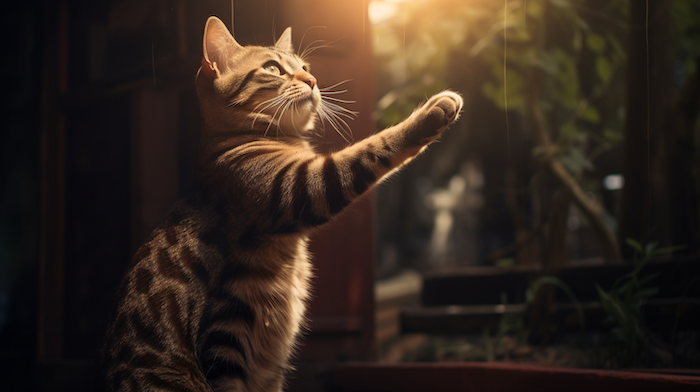Cats, with their mysterious allure, independent personalities, and quirky behaviors, often leave their human companions scratching their heads. While they might not “talk” in the conventional human sense, cats are masters at communicating their feelings, needs, and desires through their body language. If you’ve ever wondered what your feline friend is trying to convey, this guide is here to help you decipher the enigma that is cat body language.
1. The Tale of the Tail
The tail is a cat’s emotional barometer. By simply observing it, you can get a pretty accurate idea of how your cat feels.
- Elevated Tail: A tail held high is a sign of a confident, happy cat. If the tail quivers while it’s elevated, it often indicates extreme excitement, especially if they’ve just spotted you after a long day!
- Swishing or Lashing Tail: Contrary to a dog’s wagging tail, a cat that’s rapidly swishing or lashing its tail is usually agitated or annoyed. If your cat is in this mood, it’s best to give them some space.
- Tucked Tail: A tail tucked beneath the body signals fear or submission. It may also indicate discomfort or uncertainty.
- Puffed Up Tail: This is your cat’s way of trying to appear larger to ward off perceived threats. It’s often accompanied by an arched back.
2. Eyes: Windows to the Feline Soul
Cats communicate volumes with their eyes. Recognizing these signals can be invaluable in strengthening the bond with your feline companion.
- Dilated Pupils: This can mean a variety of things. Your cat might be excited, nervous, stimulated, or even scared. Context is key here.
- Constricted Pupils: This may indicate that your cat is tense or possibly aggressive. Again, the surrounding context will provide a better clue.
- Slow Blinking: Often dubbed “cat kisses”, when your cat slowly blinks at you, it’s a sign of trust and affection. You can blink back to return the sentiment!
3. Whisker Wisdom
Whiskers, or vibrissae, are highly sensitive tactile hairs that provide cats with information about their surroundings. Their positioning can also offer insights into a cat’s mood.
- Forward-facing: Indicates that the cat is curious or excited.
- Flat against the face: This is a sign of fear, anxiety, or aggression.
- Neutral Position: Your cat is relaxed and content.
4. Vocal Vibrations
While this section focuses predominantly on body language, it’s worth noting the various vocal cues cats provide. From meows and purrs to hisses and growls, each sound holds significance.
- Meowing: This is primarily used for human-cat communication. The tone, frequency, and volume can range depending on what they’re trying to convey – be it hunger, attention-seeking, or annoyance.
- Purring: While it’s mostly associated with contentment, cats also purr when they’re in pain or anxious, so always consider the context.
- Hissing & Growling: Clear signals to back off. Your cat feels threatened or is highly annoyed.
5. Posture & Gestures
The way a cat positions its body and its various gestures can be indicative of its emotions and intentions.
- Kneading: When cats push their paws in and out against a soft surface, it’s a comforting gesture that originates from their kittenhood when they kneaded their mother’s belly for milk.
- Belly Up: Displaying their belly is a sign of trust. However, it can also be a defensive pose. Ensure you understand your cat’s boundaries before giving belly rubs.
- Arching the Back & Puffing Up: This is a defensive stance. The cat is trying to appear bigger to ward off a threat.
- Head-Butting: A gentle push with their head is a sign of affection and a request for attention.
Conclusion
Understanding cat body language is akin to learning a new language. It requires patience, keen observation, and sometimes a bit of trial and error. Each cat is unique with its own set of quirks and preferences. The more time you spend observing and interacting with your feline friend, the more fluent you’ll become in their non-verbal cues.
Just remember, every gesture or pose is a piece of a larger puzzle. For instance, a purring cat with a lashing tail may be simultaneously content and annoyed. As with any relationship, the bond between a cat and its human grows stronger with time, patience, and understanding. So, the next time your feline friend gives you a long slow blink or flicks its tail, you’ll be better equipped to respond in kind.

